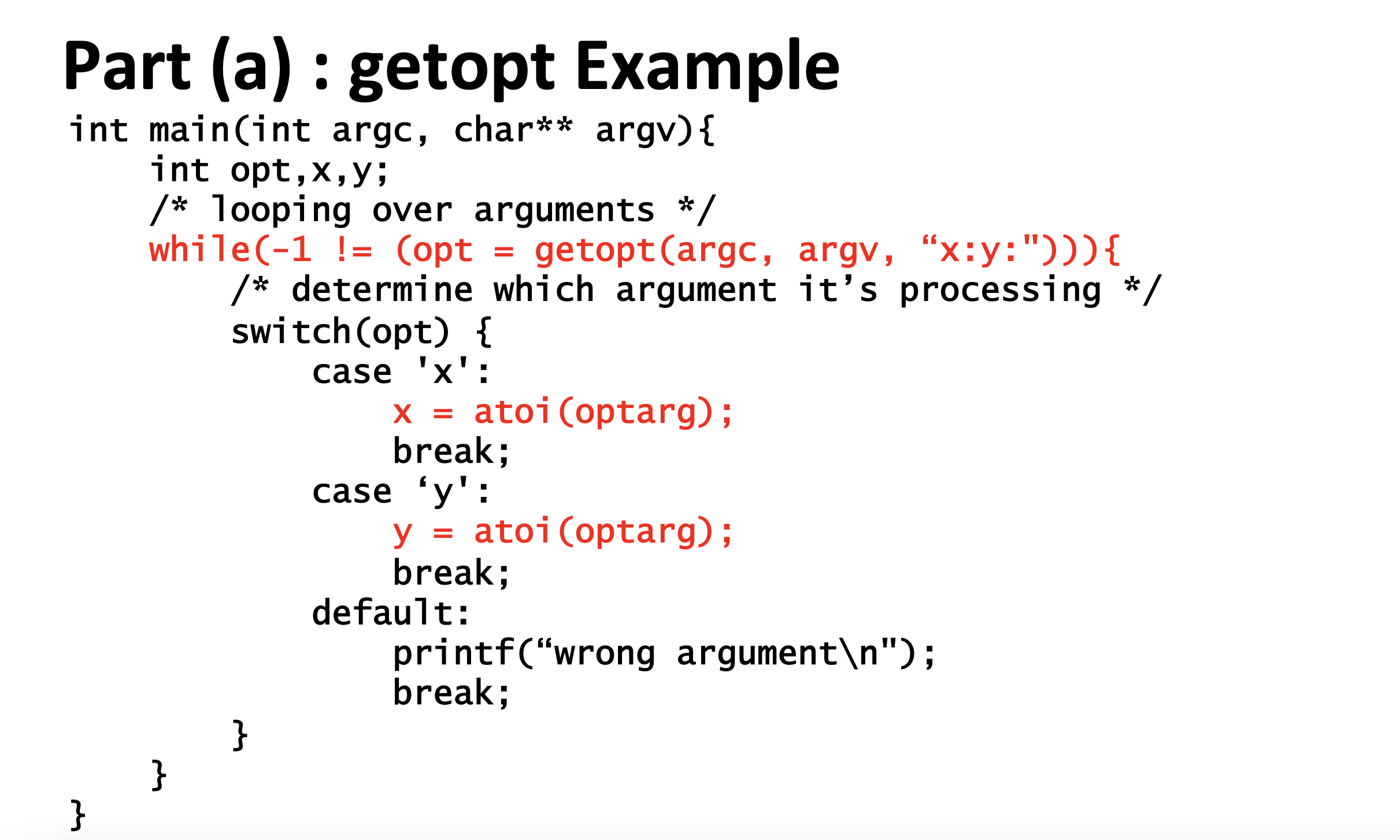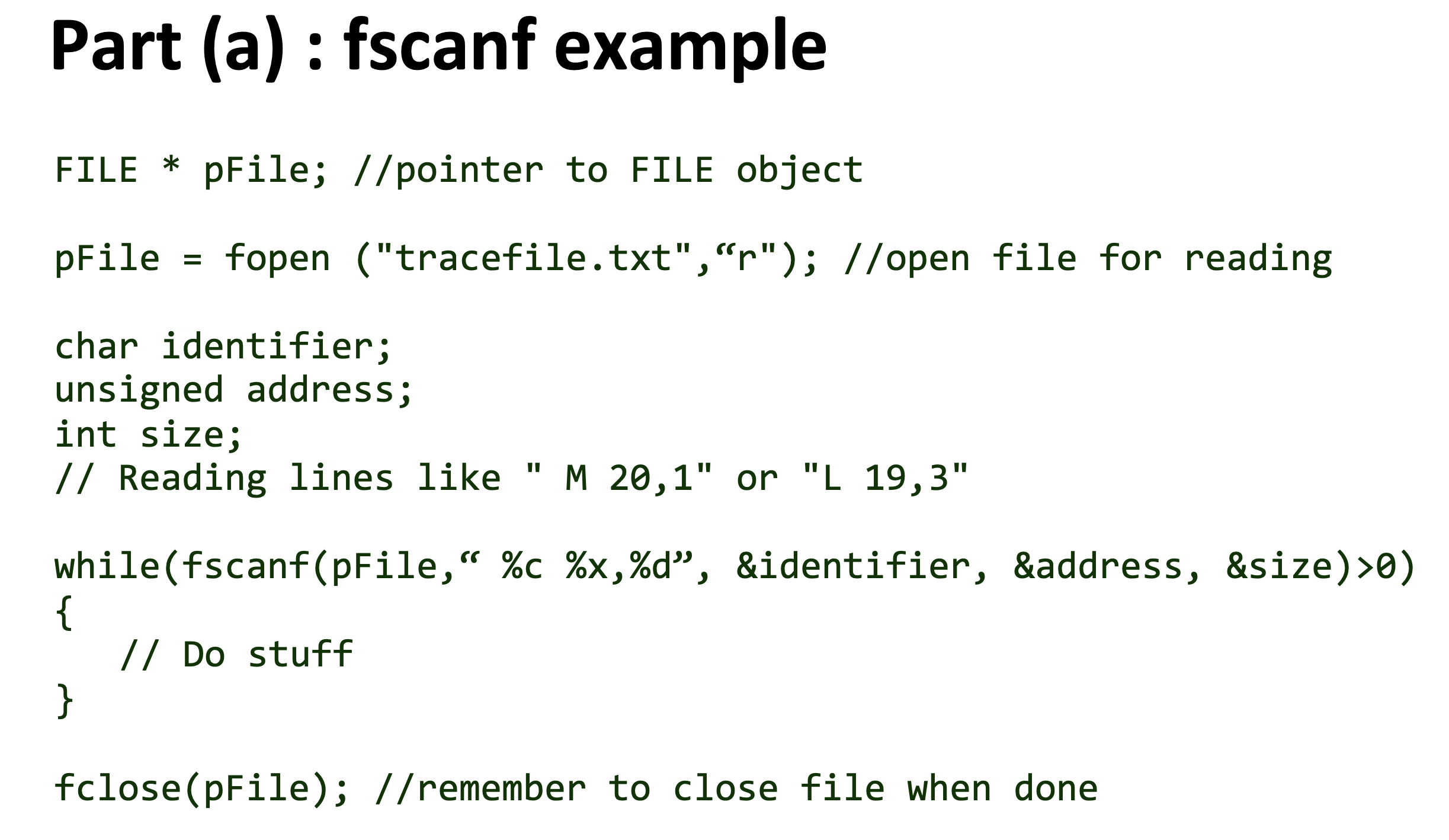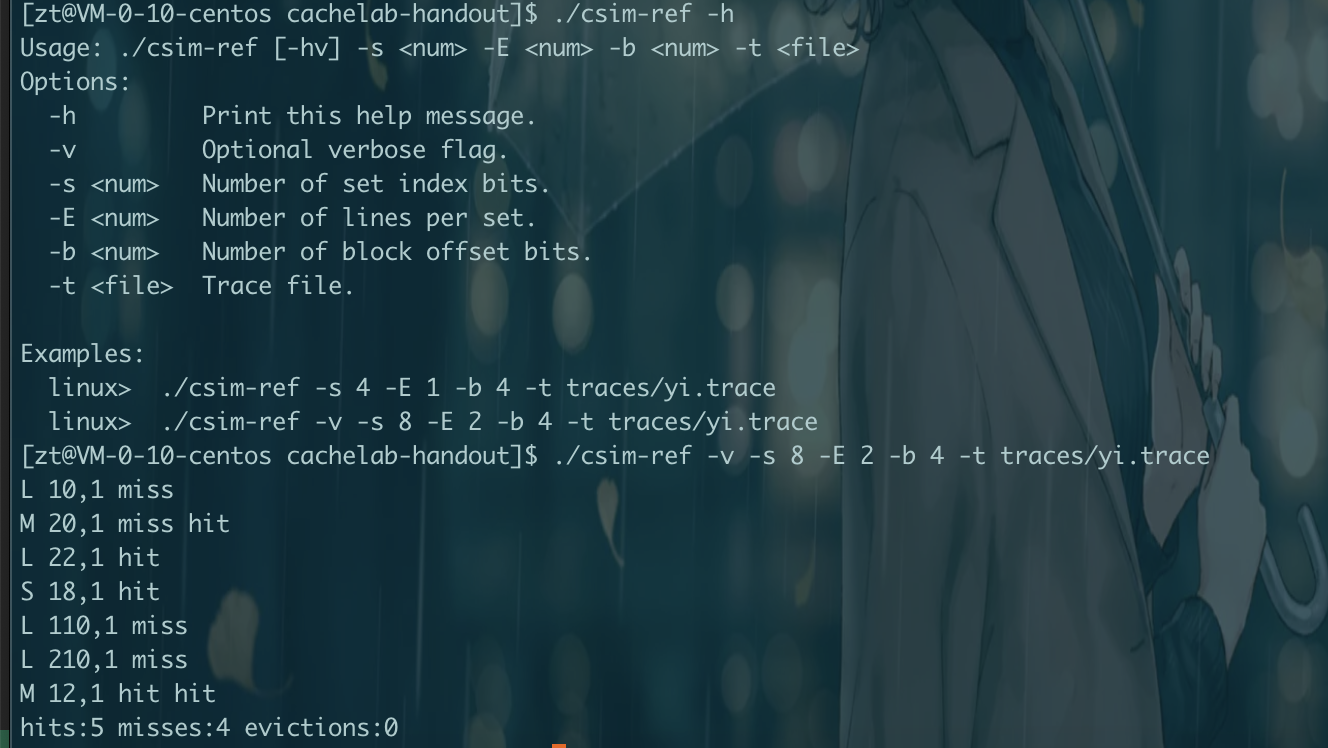1
2
3
4
5
6
7
8
9
10
11
12
13
14
15
16
17
18
19
20
21
22
23
24
25
26
27
28
29
30
31
32
33
34
35
36
37
38
39
40
41
42
43
44
45
46
47
48
49
50
51
52
53
54
55
56
57
58
59
60
61
62
63
64
65
66
67
68
69
70
71
72
73
74
75
76
77
78
79
80
81
82
83
84
85
86
87
88
89
90
91
92
93
94
95
96
97
98
99
100
101
102
103
104
105
106
107
108
109
110
111
112
113
114
115
116
117
118
119
120
121
122
123
124
125
126
127
128
129
130
131
132
133
134
135
136
137
138
139
140
141
142
143
144
145
146
147
148
149
150
151
152
153
154
155
156
157
158
159
160
161
162
163
164
165
166
167
168
169
170
171
172
173
174
175
176
177
178
179
180
181
182
183
184
185
186
187
188
189
190
191
192
193
194
195
196
197
198
199
200
201
202
203
204
205
206
207
208
209
210
211
212
213
214
| #include "cachelab.h"
#include <unistd.h>
#include <getopt.h>
#include <stdio.h>
#include <stdlib.h>
typedef struct{
int valid;
int tag;
int time_stamp;
} cache_line;
int timestamp = 0;
int find_hit_cache(cache_line *cache_line,int E,int tag, int*hits) {
int isHit = 0;
for(int i = 0; i < E; i++) {
if (cache_line[i].valid == 1 && cache_line[i].tag == tag ) {
printf("hit \n");
*hits = *hits + 1;
isHit = 1;
cache_line[i].time_stamp = timestamp;
return isHit;
}
}
return isHit;
}
int find_empty_cache(cache_line *cache_line,int E,int tag) {
int have_empty_cache = 0;
for (int i = 0; i< E; i++) {
if (cache_line[i].valid == 0) {
cache_line[i].valid = 1;
cache_line[i].tag = tag;
cache_line[i].time_stamp = timestamp;
have_empty_cache = 1;
return have_empty_cache;
}
}
return have_empty_cache;
}
int get_eviction_index(cache_line *cache_line, int E) {
int max_time_stamp = timestamp;
int eviction_index = -1;
for (int i = 0; i< E; i++) {
if (cache_line[i].time_stamp < max_time_stamp) {
max_time_stamp = cache_line[i].time_stamp;
eviction_index = i;
}
}
return eviction_index;
}
void LRU(cache_line *cache_line, int E,int tag) {
int eviction_index = get_eviction_index(cache_line, E);
cache_line[eviction_index].valid = 1;
cache_line[eviction_index].tag = tag;
cache_line[eviction_index].time_stamp = timestamp;
}
int load_and_store(unsigned address,int b,int s,int u_max,int E,cache_line **cache, int *hits,int *misses,int *evications) {
int set_index,tag;
set_index = (address >> b) & u_max;
tag = (address >> b) >> s;
int isHit = find_hit_cache(cache[set_index], E, tag, hits);
if (isHit == 0) {
printf("miss \n");
*misses = *misses + 1;
int have_empty_cache = find_empty_cache(cache[set_index], E, tag);
if (have_empty_cache == 0) {
printf("evictions \n");
*evications = *evications + 1;
LRU(cache[set_index], E, tag);
}
}
timestamp++;
return 0;
}
int main(int argc, char** argv)
{
int opt,v,s,E,b,S,B;
FILE * pFile;
while(-1 != (opt = getopt(argc, argv, "h?v?s:E:b:t:"))){
switch(opt) {
case 'h':
printf("./csim: Missing required command line argument \n Usage: ./csim-ref [-hv] -s <num> -E <num> -b <num> -t <file> \n Options: \n -h Print this help message. \n -v Optional verbose flag. \n -s <num> Number of set index bits. \n -E <num> Number of lines per set. \n -b <num> Number of block offset bits. \n -t <file> Trace file. \n\n Examples: \n ./csim -s 4 -E 1 -b 4 -t traces/yi.trace \n ./csim -v -s 8 -E 2 -b 4 -t traces/yi.trace \n");
break;
case 'v':
v = 1;
printf("v:%d \n",v);
break;
case 's':
s = atoi(optarg);
S = 1 << s;
printf("s:%d, S:%d \n",s,S);
break;
case 'E':
E = atoi(optarg);
printf("E:%d \n",E);
break;
case 'b':
b = atoi(optarg);
B = 1 << b;
printf("b:%d, B:%d \n",b,B);
break;
case 't':
pFile = fopen(optarg,"r");
printf("t:%s, file:%p \n",optarg,pFile);
break;
default:
printf("非法参数 \n");
break;
}
}
if(s == 0 || E == 0 || b == 0) {
return 0;
}
cache_line **cache = (cache_line **)malloc(S * sizeof(cache_line *));
if (cache == NULL) {
printf("内存分配失败 \n");
}
for(int i = 0; i < S; i++) {
cache[i] = (cache_line *)malloc(E * sizeof(cache_line));
if(cache[i] == NULL) {
printf("内存分配失败,开始回滚 \n");
for (int j = 0; j < i; ++j) {
free(cache[j]);
}
free(cache);
}
}
int u_max = 1;
for(int i = 0; i < s - 1; i++) {
u_max = (u_max << 1) | 1;
}
char identifier;
unsigned address;
int size;
int hits,misses,evictions;
while(fscanf(pFile," %c %x,%d",&identifier,&address,&size)>0)
{
if (identifier == 'L' || identifier == 'S'){
printf("identifier %c, addr:%x, size:%d \n",identifier,address,size);
load_and_store(address,b,s,u_max,E,cache,&hits,&misses,&evictions);
} else if (identifier == 'M') {
printf("identifier %c, addr:%x, size:%d \n",identifier,address,size);
load_and_store(address,b,s,u_max,E,cache,&hits,&misses,&evictions);
load_and_store(address,b,s,u_max,E,cache,&hits,&misses,&evictions);
}
}
fclose(pFile);
printSummary(hits, misses, evictions);
for(int i = 0; i< S; i++) {
free(cache[i]);
}
free(cache);
return 0;
}
|


